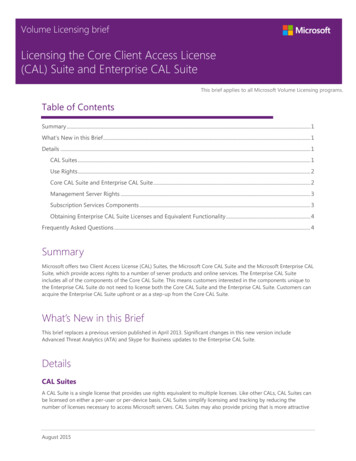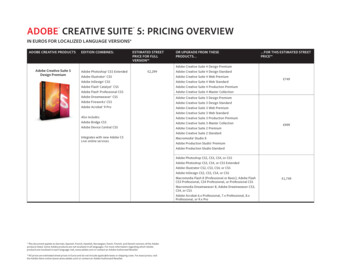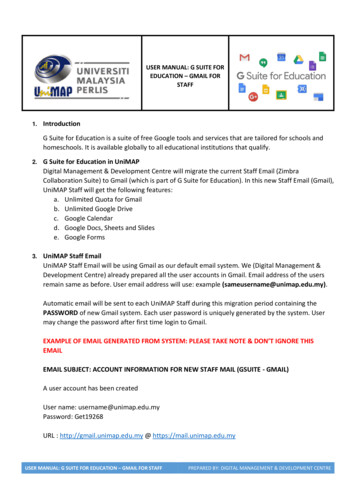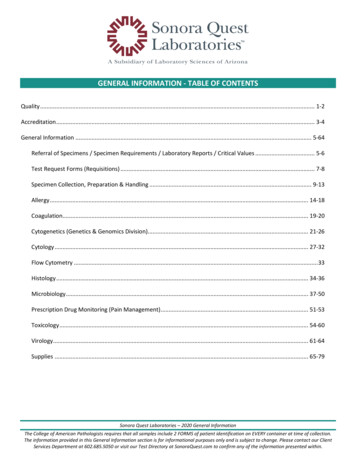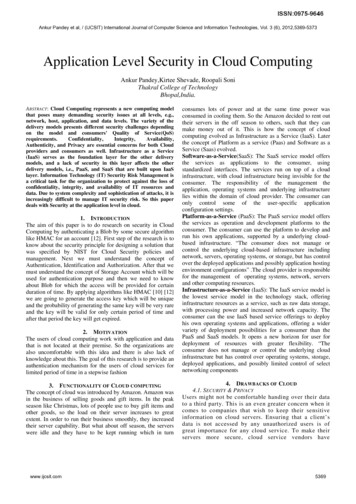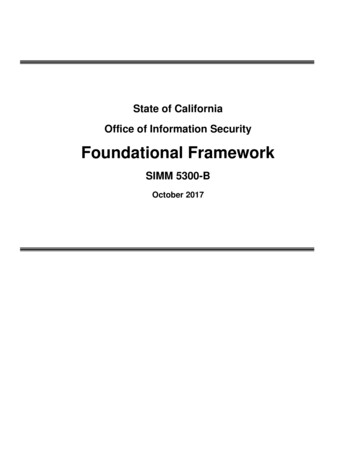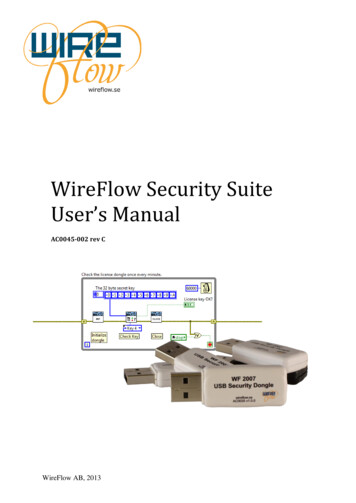
Transcription
WireFlow Security SuiteUser’s ManualAC0045-002 rev CWireFlow AB, 2013
WireFlow AB,WireFlow Security SuiteContentsSupport information . 2Technical support and Product information . 2WireFlow headquarters . 2Introduction . 3How it works . 4Using asymmetric keys . 6The components . 7The dongles . 7The Security Suite Programming application . 7The LabVIEW drivers . 7The technology behind the Security Suite. 8SHA-256 . 8Hash functions . 8The implementation in the Security Suite . 8Symmetric keys . 8Asymmetric keys . 9The USB Hardware . 10Dimensions . 10Electromagnetic Compatibility . 11CE Compliance . 11The WF 2007 . 11The WF 2008 . 11Security Suite Programming Application . 12Requirements . 12Installation and licensing . 12Description of the front panel objects . 13Using the program . 15Factory setting . 15Managing a dongle . 15Configuration files . 16The WF USB Security dongle driver . 16Requirements . 16Installation . 16Device driver for Windows . 17Installed items . 17The basic VIs . 17The intermediate VIs . 19The WF Authentication module . 20Requirements . 21Installation . 21Installed items . 21The VIs . 22 WireFlow AB, 2014AC0045-002 rev C1
WireFlow AB,WireFlow Security SuiteSupport informationTechnical support and Product low headquartersWireFlow ABTheres Svenssons gata 10SE-417 55 GöteborgSweden WireFlow AB, 2014 WireFlow AB, 2014AC0045-002 rev C2
WireFlow AB,WireFlow Security SuiteIntroductionThis chapter gives a brief introduction to all parts included in the WireFlow Security Suite. Ifyou prefer hands-on practice, you may skip this and instead go directly to the Quick guidedocument: “AC0045-003 WF Security Suite - Quick Guide”The WireFlow Security Suite is a comprehensive solution that ends IP protection issuesrelating to unlawful copying of LabVIEW code. Not only does the Security Suite prohibittheft of code, the system also enables user identification and system feature control.The WF Security Suite uses dongles, "hardware keys" to protect the LabVIEW applications.Software protection dongles have been used since late 1970s, and is a well-proven, intuitiveand robust method to handle software licensing.The WF Security Suite uses hardware dongles and LabVIEW software drivers based on theindustry standard SHA-256 hash algorithm with 256 bit keys, guaranteeing a rock solidsolution.The WF Security Suite is fully compatible with all LabVIEW platforms, including LabVIEWfor Windows, LabVIEW for Mac, LabVIEW Real-Time and LabVIEW FPGA.The WireFlow dongles may thus be used to protect all LabVIEW hardware targets such asdesktop PCs, PXI, Compact RIO and Compact DAQ chassis. WireFlow AB, 2014AC0045-002 rev C3
WireFlow AB,WireFlow Security SuiteIt is easy to protect a LabVIEW application by adding security routines to the code using theWF Security Suite LabVIEW driver. The security functionality can be anything from a simplelicense key check at the start-up of the application, to a complex set of functions to handleuser identification and privileges or to handle demo expiration timers.How it worksThe security dongles may be thought of as an ordinary USB flash memory which cannot beread, written or duplicated by anyone that doesn't know the secret master code of the dongle.The LabVIEW developer can use this to implement a variety of security functions in theLabVIEW application. One basic security function is to make sure that the application doesnot start in case there is no dongle with the correct key present in the system. The flow chartand LabVIEW code for such an application would look something like this:Flow chartLabVIEW implementationStartNoDongleKey ok?YesMainprogramEndIn the example above it is the LabVIEW VI CheckCryptoKey.vi (the one with the key symbolon the icon) that checks that the Key 5 memory in the dongle has the correct value. Thecommunication between this LabVIEW VI and the dongle is encrypted to avoid the systembeing hacked. Please see chapter The technology behind the Security Suite for more detailsregarding this encrypted communication.Before shipping the LabVIEW application to the end customer, the application must be builtinto an .exe file (or .rtexe or .lvbit etc) to make sure that the end user cannot find the secretkey by analysing the source code. (Or use asymmetric keys to prevent end user to find out thesecret key even if he can analyse the source code. Please see the chapter Using asymmetrickeys for more information).A mentioned before the dongle may be thought of as an ordinary USB flash memory thatholds secret keys and data. The WireFlow dongles have a memory structured like this: WireFlow AB, 2014AC0045-002 rev C4
WireFlow AB,Master KeyWireFlow Security SuiteKey 1Key 2Data Field 1Key 3Data Field 2Key 4Data Field 3Key 5Key 6Arrows indicate parentKey for a specific operationWrite KeyKey 7Read KeyKey 8Each rectangle represents a 32 byte (256 bits) memory cell. The 9 keys can be written and"queried for match" but cannot be read. The data fields can be both written and read.When doing a "query" it is checked if a key has a specific value. The result of this query isTrue or False.To read a data field, the value of its parent key must be specified. WireFlow AB, 2014AC0045-002 rev C5
WireFlow AB,WireFlow Security SuiteTo write a new value to a key or data field, the value of its parent key must be specified.Using asymmetric keysThere is a more advanced way of protecting the secret key, by using asymmetric keys.By using asymmetric keys you never have to store the actual key in your application.This means that even if someone looks in the source code they can’t manufacture their owndongles using that information.To use this function the secret key must first be run through a hash algorithm. This can bedone using the VI CreateHashFromKey.vi in the Dongle Authentication driver or the hashedkey can be seen in the Security Suite Programming Application (see more in the chapter onthe Security Suite Programming Application).After a hashed key is created (either in the Security Suite Programming Application or byusing the authentication driver), the check should be implemented by setting the input“hashed key? (FALSE)” to true and to use the hashed key as key value. WireFlow AB, 2014AC0045-002 rev C6
WireFlow AB,WireFlow Security SuiteBy doing this the real key will never be present in your application.The componentsThe WireFlow security suite provides a complete set of components used to add softwaresecurity to LabVIEW applications.The donglesTwo types of dongles are currently available: The WF 2008 is an USB dongle for standard LabVIEW for Windows, Mac and Linux. The WF 2007 is an USB dongle for LabVIEW RT (Real Time) platforms.The Security Suite Programming applicationThe programming application is a Windows application used to program and manage thedongles. It is with this application you program the secret keys into the dongles.The LabVIEW driversThe LabVIEW drivers are used to add software protection into your applications. There areactually two sets of drivers The WF USB Security dongle driver is the basic driver to communicate with the USBdongles and to do key validation etc. The WF Authentication module contains low level functions used by the WF USBSecurity dongle driver. It can be used by itself by advanced users that need advancedsecurity functions, such as separating the dongle communication from theauthentication control into separate targets etc. WireFlow AB, 2014AC0045-002 rev C7
WireFlow AB,WireFlow Security SuiteThe technology behind the Security SuiteThis chapter will go through the basic functions of the technology that is used in the Securitysuite. After you read this chapter you will have a better understanding of the functions that theSecurity Suite offers.SHA-256The key functionality in the Security Suite is built around the SHA-256 algorithm. Thisalgorithm is part of the SHA 2 family which is used throughout many different applicationstoday.The SHA-2 hash function is implemented in some widely used security applications andprotocols, including TLS and SSL, PGP, SSH, S/MIME, Bitcoin and IPsec.Hash functionsThe SHA 2 family is based upon the use of hashes.A hash function is an algorithm that transforms (hashes) an arbitrary set of data elements,such as a text file, into a single fixed length value (the hash). The computed hash value maythen be used to verify the integrity of copies of the original data without providing any meansto derive said original data.As the name implies the SHA 256 is built upon hashes with the internal length of 256 bits (32bytes).The implementation in the Security SuiteThe WireFlow Security Suite uses SHA-256 in conjunction with random numbers to make thepassword comparison. Two slightly different sequences are used depending on the type of keythat is used, i.e. symmetric or asymmetric keys. (Note that this is a schematic picture and maynot exactly represent every input and output of every step in the process.)Symmetric keys1.2.3.4.Both the dongle and the LabVIEW driver generate a random number and thesenumbers are sent to each other. The use of random numbers will make the SHA256 result different every time it’s run, thus making sniffing on the interfacebetween the dongle and the LabVIEW code useless as there will be a differentresult every time.Both the dongle and the LabVIEW code combine the secret key and the tworandom values created in step 1.A SHA-256 calculation is made on the result from step 2.The driver gets the result from the SHA-256 from the dongle and compares thisto its own SHA-256 result. If the secret key has the same value in both dongleand driver, then the SHA-256 results will match. WireFlow AB, 2014AC0045-002 rev C8
WireFlow AB,WireFlow Security SuiteSecret keyRandomSecret keyRandomSHA-256SHA-256SHA-256SHA-256X Y?LabVIEWsoftwareSecuritydonglePass/FailAsymmetric keysThe difference here compared to the symmetric keys is that the hash of the secret key is doneoffline in advance for the LabVIEW part. Since only the hashed key is stored in the LabVIEWsoftware the secret key cannot be obtained even if studying the LabVIEW source code.Secret keyOfflinepreparationSHA-256RandomRandomSecret keySHA-256Hashed keySHA-256SHA-256X Y?LabVIEWsoftware WireFlow AB, 2014SecuritydonglePass/FailAC0045-002 rev C9
WireFlow AB,WireFlow Security SuiteThe USB HardwareThe USB security dongles used a dedicated crypto chip for secure storage of the secret keys.An embedded processor handles the interface between the cryptochip and the USB interface.Inside the crypto chip there are twelve 32 byte (256 bits) memory cells. Nine of these are usedfor keys that may be written and "queried for match" but may not be read. Three data fieldsmay be written and read.Each memory cell has a guaranteed life of 100.000 write cyclesWhen dongles are shipped from WireFlow they have a factory setting like this:Memory cellMaster KeyKey 1Key 2Key 3Key 4Key 5Key 6Key 7Key 8Data Field 1Data Field 2Data Field 3Factory settingEncrypted value0x01, 0x01, 0x01, 0x01 .Encrypted valueEncrypted value0x04, 0x04, 0x04, 0x04 .0x05, 0x05, 0x05, 0x05 .0x06, 0x06, 0x06, 0x06 .0x07, 0x07, 0x07, 0x07 .Encrypted value0xD1, 0xD1, 0xD1, 0xD1 .0xD2, 0xD2, 0xD2, 0xD2 .0xD3, 0xD3, 0xD3, 0xD3 .The cells that have "Encrypted value" in the factory setting can only be reprogrammed usingthe WF Security Suite Programming Application. Think of it as a kind of activation of thedongles that is needed before they can be used.Dimensions WireFlow AB, 2014AC0045-002 rev C10
WireFlow AB,WireFlow Security SuiteElectromagnetic CompatibilityThe USB security dongles meets the requirements of the following EMC standards forelectrical equipment for measurement, control, and laboratory use: SS EN 61326-1:2013 Electrical equipment for measurement FCC Part 15 EmissionsCE ComplianceThe USB security dongles meets the essential requirements of applicable European Directivesas follows: 2004/108/EC; Electromagnetic Compatibility Directive (EMC)The WF 2007The WF 2007 is the key to use if you want to protect a LabVIEW RT (Real Time) application.It will work on any RT target such as cRIO, PXI or desktop targets as long as there is a freeUSB slot.The WF 2008The WF 2008 will work on any LabVIEW targets such as standard PC/MAC or Linuxmachine with a spare USB slot. It will also work on for example a PXI controller runningWindows. WireFlow AB, 2014AC0045-002 rev C11
WireFlow AB,WireFlow Security SuiteSecurity Suite Programming ApplicationWhen receiving your dongles from WireFlow they have to be programmed with your specificsecret key(s). The Programming application is the tool to help you manage this.This chapter will guide you through the steps of that process.RequirementsLabVIEW 2011 runtime, download hereNI-VISA (version 5.4), download hereInstallation and licensingThe Security Suite Programming Application may be downloaded from www.wireflow.se.Run the installer and follow the online instructions for installation.The setup file doesn’t include LabVIEW 2011 runtime or the required NI-VISA driver butthey can be found on NI’s webpage for download (if you have LabVIEW 2011 or laterinstalled they are probably already installed).Besides installing the application, you will also need to install the WF USB dongle devicedriver for Windows.The device driver is an .inf file that can be found on your computer in the folder:C:\ProgramData\WireFlow\WF Security Suite\Device driver\Windows DevicedriverThe device driver .inf file can also be downloaded from www.wireflow.se. WireFlow AB, 2014AC0045-002 rev C12
WireFlow AB,WireFlow Security SuiteFollow the installation instruction located together with the .inf file.To be able to program your dongles with new keys you will have to acquire a license for thetool. The license will come in the form of a USB dongle (what else :-) as seen in the picturebelow.There are different options for the License dongle depending which USB HW you want toprogram. Either you buy a license where you will be able to program WF 2007, WF 2008 oryou buy the option to program both the WF 2007 and WF 2008. You will only be able toprogram the type of dongles that you acquired license for.For pricing information please go to www.wireflow.seDescription of the front panel objectsLoads query values from file.Saves current query values to fileSave current hashed values to fileLoad commit values from fileSaves current commit values to fileWrite all current commit values to the dongleMakes a forced refresh on all dongles.Opens this manualGives you information about the Programming Application andinserted dongles. Use this information if you need to create atrouble report.Indicates if a dongle (WF2007, WF2008) is detected.Indicates that the detected dongle has factory default valuesLit when a (black) License Dongle is detected in the system WireFlow AB, 2014AC0045-002 rev C13
WireFlow AB,WireFlow Security SuiteLit when there is a correct license on the License Dongle toprogram the detected dongle (WF2007, WF2008)Each of these boxes represent a memory cell in the crypto chip. Inthis case it is the Key 1 cell. The DCDB. indicates the two firstbytes of the in total 32 byte long so-called Query value. The greenLED indicates that the Query value is matched to the content ofthe cell. This means that when LED is green we know the valueof the cell, i.e. the query value. If LED is off, we do not know thecontent of the cell. We cannot read the content. We can onlyprovide a query value and then check if it is a match or not. Youmay notice that the box has an orange outline. This indicates thatyou may write a new data to the cell. Precondition for this is thatyou have a correct query value for the parent cell.This is a "write-arrow". It indicates which key/box that must havea green LED in order to be able to write a new value into the cell.Note that the Master key is very important. As long as you knowthe master key you can re-program the dongle. If you lose theMaster key you can no more re-program the dongle.This is a "read-arrow". It indicates which key/box that must havea green LED in order to be able to read the value from the cell.Shows information on the detected dongleThe dongle management field is located in the lower part of the application. It is here that youcan analyse and re-program the 32 bytes in a specific cell. WireFlow AB, 2014AC0045-002 rev C14
WireFlow AB,WireFlow Security SuiteIt’s also where you can see the hashed value of the current Query value. This value should beused in your application if you are using asymmetric keys.Using the programSince the program cannot read data cells from the dongles, but only query and check values itis important to know the content of the dongle to be able to re-program the dongle. Thereforemake sure to always keep track of the values you program into a dongle. You can use theSave commit values button to save your programmed values to file.Factory settingWhen a dongle is shipped from WireFlow it has a factory setting, please see chapter The USBHardware.When a dongle is detected by the WF programming application it will always check for thefactory setting. If a factory default value is detected then the program will automatically fill inthis value into the Query value field. The program also knows how to decrypt the three cellsthat are encrypted in the factory setting. The only way to decrypt the cells that are encryptedin the factory setting is to use the WF Programming Application to decrypt it.Managing a dongleIn the dongle management field in the lower part of the application, you can see the textMaster Key in the top left corner.This indicates that it is the Master Key that is now selected. To select another cell, just clickon the desired box in the memory overview layout.To check if a specific cell has a specific value you should enter the 32 byte value in the Queryfield (and press Return). Now check if the green LED in the corresponding box turns on oroff. If it is on then you have the correct value in the Query field.In the Hashed value field you can see the hashed value of the current Query value. The hashedvalue should be used instead of the Query value when using asymmetric keys.To write a new value to a cell you must first make sure that the cell has an orange borderaround the box. You will get this by entering the correct Query value of the parent key. Justfollow the orange write-arrow backwards to find the parent key.When you have the orange border make sure to select the cell that you want to write to. Nowfill in the desired data in the Commit value. Press the Write Commit value button to write tothe key.The Key comment can be used for descriptive text. This will not be programmed into thedongle. It is a text only used by this program. The comment will be stored in the configurationfiles when pressing Save query values or Save commit values. WireFlow AB, 2014AC0045-002 rev C15
WireFlow AB,WireFlow Security SuiteConfiguration filesWhen you have programmed a dongle the way you want, it is possible to store thisconfiguration in a configuration file.To be sure to save the data for all fields, you should fill in data for all cells in the Commitfield. When this is done you can save all commit data to file by pressing Save commit values.If you are going to create several dongles with this setup then you just insert a new dongle(with factory setting). The tool will notice that it is a with factory setting and willautomatically fill in the correct Query values and turn on all the green LED's.Now press Load commit values and then press Write All to program a new dongle identical tothe one you did when you saved the configuration file.Note that the query file format is identical to the commit file format. This means that you cando a Save commit values and then read the same file with Load query values. This feature canbe used to copy data from one dongle to another etc.The WF USB Security dongle driverThis easy-to-use LabVIEW driver is used to add security functions to LabVIEW applications.RequirementsLabVIEW (version 2011)NI-VISA (version 5.4)VI Package Manager (for installation)NI-VISA USB Passport (Needed for RT targets only)InstallationThe WF USB Security dongle driver may be downloaded from www.wireflow.se. For theinstallation you will need the VI Package Manager which may be downloaded fromwww.ni.com or from jki.net. The installation procedure is quite straightforward. Just followthe online instructions. WireFlow AB, 2014AC0045-002 rev C16
WireFlow AB,WireFlow Security SuiteNote that the WF USB Security dongle driver uses functions included in the WFAuthentication module, so you must install that driver also. It may also be downloadedwww.wireflow.se.Device driver for WindowsTo be able to run the code against the USB dongles on Windows platform you also need toinstall the WF USB dongle device driver for Windows.The device driver is an .inf file that can be found on your computer in the folder:C:\ProgramData\WireFlow\WF Security Suite\Device driver\Windows DevicedriverThe device driver .inf file can also be downloaded from www.wireflow.se.Follow the installation instruction located together with the .inf file.Installed itemsThe driver VIs are found in the functions palette:The user's manual is installed and found under the menu Help WireFlowSome developers tools are found under the menu Tools WireFlowExamples are found under the menu Help Find Examples.To find the examples select the Search tab and then perform a search for the keywords“dongle” or “WireFlow”The basic VIsThe basic VIs are found in the tools palette: WireFlow AB, 2014AC0045-002 rev C17
WireFlow AB, WireFlow Security SuiteThere are two VIs for connecting and disconnecting to a dongle (Init and Close).There are two VIs for writing and reading to the data fields (WriteDataField andReadDataField).There are VIs for writing and checking key values (WriteKeyValue andCheckCryptoKey). Remember that key values cannot be read, only checked.There is one VI for changing the behaviour of the internal LED in the HW calledSetLED-State.There are two VIs to initiate and check a Session Key, i.e. a key only used in thesession.There are two VIs to be used for remote/offline challenge response, e.g. to validate acommunication linkThere is one VI to create cryptographically safe random number.Finally there is one VI called FindDonglesInSystem which can be used for the rarecase that your application should need to use multiple dongles in the same system. WireFlow AB, 2014AC0045-002 rev C18
WireFlow AB,WireFlow Security SuiteThe diagram above shows how easy it can be to implement a check that a dongle with thecorrect key is inserted into the system. Just do; Init, CheckCryptoKey and Close.Please also study the other basic examples found under Help Find Examples. They willgive examples on how to implement user identification, demo time expiration etc.The intermediate VIsThe intermediate VIs are found in this palette: WireFlow AB, 2014AC0045-002 rev C19
WireFlow AB,WireFlow Security SuiteThese VIs are available for users that need to do more advanced functions. With these VIsyou can for example manage systems with multiple dongles. You can check if a dongle is stillactive etc.You can also use these VIs together with VIs from the WF Authentication module library tocreate advanced applications that separate the authentication functions from the USB donglecommunication. By doing like this it is for example possible to check that a specific dongle isinserted on a specific computer elsewhere. It can for example be used for user identificationon remote machines etc.The following example illustrates how this kind of application can be implemented.To gain more knowledge on the intermediate VIs please read the VI info for each VI andstudy the intermediate examples available under Help Find Examples.The WF Authentication moduleThe Authentication module is responsible for the encoding/decoding as well as the calculationof expected results for a Key check.Although this driver is able to run stand-alone it is designed to be used with hardware fromthe WF Security Suite. The standard user of the WireFlow security Suite will not use theseVIs directly. Instead he will only use these VIs indirect via the more easy to use WF USBSecurity dongle driver WireFlow AB, 2014AC0045-002 rev C20
WireFlow AB,WireFlow Security SuiteRequirementsLabVIEW (version 2011)VI Package Manager (for installation)InstallationThe WF Authentication module may be downloaded from www.wireflow.se. For theinstallation you will need the VI Package Manager which may be downloaded fromwww.ni.com or from jki.net. The installation procedure is quite straight forward. Just followthe online instructions.Installed itemsThe module VIs are found in the functions palette:The user's manual is installed and found under the menu Help WireFlowExamples are found under the menu Help Find Examples.To find the examples select the Search tab and then search on the keyword dongle orWireFlow WireFlow AB, 2014AC0045-002 rev C21
WireFlow AB,WireFlow Security SuiteThe VIsThe VIs are found in the tools palette:As mentioned before these VIs are normally not used directly by the application programmer,instead they are used as subVIs for
The WireFlow Security Suite is a comprehensive solution that ends IP protection issues relating to unlawful copying of LabVIEW code. Not only does the Security Suite prohibit theft of code, the system also enables user identification and system feature control. The WF Security Suite uses dongles, "hardware keys" to protect the LabVIEW applications.

